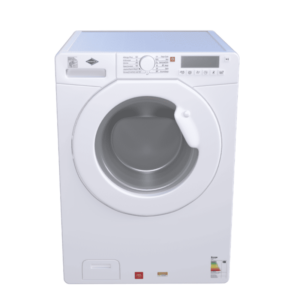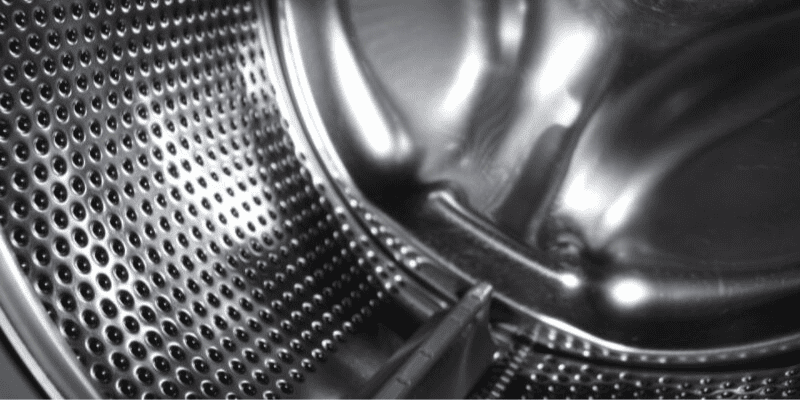Washing machines are seemingly always running within your home, as load after load gets put into the machine to rid it of dirt, grime, and odors that have collected on the materials. Although the exact number of laundry loads each household cleans each week is unknown, you can guess it would be about or nearly the same as your household. Sometimes it can be 3 loads a week or even 4 or 5, just depending on the conditions in the home and how many people you have residing in this indoor environment. The more and more loads that get placed and washed in your washing machine, the higher the susceptibility is that odors and other moisture issues like mold will begin to occur in your washing machine, particularly in a new, popular front load washer.
In this article, we are going to discuss the difference between top load washers and front load washers, and what makes front load washers more susceptible to mold growth and odors within the rubber gasket of the machine.
Front Load vs Top Load Washer
 Top load washers may be a thing of the past, with the invention of the new and innovative front load washer that most people are eagerly placing inside their home’s laundry room to help in their laundry efforts. Front load washers were designed to be highly efficient machines that use less energy and less water, win-win, right? Not so fast. These types of washers have been found to contain an array of issues including the limitation of water in each cycle to properly aid in removing detergent and other debris from fabrics. This reduction in water is a major problem for front load washers, as it will lead to odor issues on the fabric of the clothing and linens that are washed.
Top load washers may be a thing of the past, with the invention of the new and innovative front load washer that most people are eagerly placing inside their home’s laundry room to help in their laundry efforts. Front load washers were designed to be highly efficient machines that use less energy and less water, win-win, right? Not so fast. These types of washers have been found to contain an array of issues including the limitation of water in each cycle to properly aid in removing detergent and other debris from fabrics. This reduction in water is a major problem for front load washers, as it will lead to odor issues on the fabric of the clothing and linens that are washed.
Front load washers are filled with issues when it comes to washing clothes and linens. We are going to break down the major flaws of front load washers and identify the problems that these washers spread to your clothing and environment.
Difference Between Front Load and Top Load Washing Machine
When selecting a washing machine for your home, there are two major kinds to choose from – top load vs front load washers. These two washing machine styles are vastly different in a multitude of functions, such as one opens from the top and the other opens from the front. Although this is a major difference between the two washing machines, there are far more that are much more important to consider when pondering which washing machine to purchase for your home.
- Agitators: Front load washing machine are structured horizontal direction without an agitator. These washing machines contain paddles on the side of the basket that help to move the clothes and stir water while the basket rotates. These paddles will interact to promote the removal of dirt from the clothes. Whereas top load washing machines are structured vertical position with an agitator placed on the vertical axis in the machine. This agitator is responsible for mixing the clothes in alternate circular direction. The agitator helps to create friction to remove dirt and debris from clothing.
- Basket Size: The size of the clothing basket can vary inside both of these washing machines. Front load washers can hold more clothes than top-loading washers because there is no agitator in the center taking up space in the basket. The more room in the washing machine basket, means more clothes that can be washed per load which will help to save time and energy.
- Electricity Consumption: Front load washing machines can collect more clothing per load which will help to reduce electricity usage. If you live in a household with a lot of people than this energy consumption savings could be significantly beneficial.
- Water and Detergent Usage: One of the main advantages of front load washing machines over top load washing machines is the reduction in water and detergent usage. Front load washing machines uses water by half the quantity of top load washers. This will result in lower water bills and a reduction in detergent. However, there have been several issues centered around this very beneficial trait of front load washers, which we will discuss further below.
How Does a Front Load Washer Work
 A front load washer functions differently than a top load washing machine, and therefore have started the craze of replacing our older traditional top load washers with the supposed better front load washer. This washer works by filling up the bottom of the inner tub with a small amount of water and using the rotation of the tub and gravity to push the clothes around the water to remove dirt and debris from the fabric.
A front load washer functions differently than a top load washing machine, and therefore have started the craze of replacing our older traditional top load washers with the supposed better front load washer. This washer works by filling up the bottom of the inner tub with a small amount of water and using the rotation of the tub and gravity to push the clothes around the water to remove dirt and debris from the fabric.
These types of washing machines have side paddles on the inside of the drum that lifts the clothes and moves them throughout the machine in the water. This acts as an agitation to the clothes and helps to remove soil trapped on the materials that are being washed.
Front Load Washer Problems
Are you experiencing a bout of issues with your front load washer? Many people who converted to the new style of front load washing machines have been able to have a first-hand experience at the array of issues created from this type of washer including odors, leaks, buildup of grime and dirt, and even potential mold growth within the gasket and tub of the washing machine. Front load washers use less water in each laundry load, which can be a significant culprit behind all of these odorous issues within the machine.
The top issues that many front load washer users complain about includes the following problems:
- Clothes Smell After Washing: Washing clothes in a front load washer is a stinky situation – literally! When you complete a wash cycle of your front load washer, it will not be odd to detect a lingering odor still present on your fabrics after washing them. This odor that is spread onto the clothing during the wash cycle is collected from inside the machine – which is known to harbor odorous bacteria within the rubber gasket of the front load washer.
- Leaking and Collecting Water: Water from inside the washing machine has been known to pour out from around the seal of the front load washer and become released onto the floor surrounding this machine. Additionally, water will pool around the seals and create a draining issue that will need to be drained using a wet vacuum or towels to eliminate the excess water.
- Super Long Wash Cycles: The wash cycle of a front load washer is typically around 54 minutes, as stated on the washing settings. However, for those who have ran this normal wash cycle on this type of machine, you will know that these cycles will really last a lot longer than 54 minutes.
- Less Water, Dirtier Clothes: Front load washing machines are known for their drastic reduction of water use per load. Although less water is a pro for many people, especially since this will save energy consumption cost in your home, the less water used will result in a less thorough rinse and wash cycle.
- Bacteria and Mold Growth: Bacteria accumulation and even mold growth is likely to occur in a front load washing machine, this can develop in various parts of the appliance like the dispensers and rubber gaskets around the door. The watertight front door of the machine will trap moisture in the rubber seal along with create pockets for mold and mildew growth to occur. As mold begins to develop this fungus can spread onto the clothes that are cleaned in the washing machine and leave potential odors on the fabric of the clothing.
Do All Front Load Washers Have Mold Problems?
 Mold problems in a front load washer are all too common, and this issue can be a major source of odors within the machine that will likely spread onto your clean clothing. The front seal that surrounds the door is the main area where mold growth can begin inside of the washing machine – this is due to the airtight seal of the gasket that will trap moisture and contribute to a desirable environment for mold to grow. When the door is continually shut after each wash cycle is completed, this will tremendously promote the growth of mold.
Mold problems in a front load washer are all too common, and this issue can be a major source of odors within the machine that will likely spread onto your clean clothing. The front seal that surrounds the door is the main area where mold growth can begin inside of the washing machine – this is due to the airtight seal of the gasket that will trap moisture and contribute to a desirable environment for mold to grow. When the door is continually shut after each wash cycle is completed, this will tremendously promote the growth of mold.
If you have noticed the development of mold growth in your washing machine there are a few things that can be done to help reduce the moisture buildup that will lead to mold. After you run a wash cycle, leave the door of the washing machine open to allow air into the basin and doors seals to help dry these areas.
How to Clean Front Load Washer Mold in Rubber Gasket
When mold begins to overtake your washer and the smell of your clean clothing, something must be done to halt this funguses growth and restore your washing machine back to clean, normal conditions. Bleach, vinegar, and borax are often the most commonly used products placed in your washing machine to help combat odors that have become trapped in the wash basin and rubber seal of the machine. However, these go-to solutions may be lacking significantly when it comes to complete odor neutralization within the entire washing machine.
Once the actual mold growth problem is resolved, the EnviroKlenz Washing Machine Deodorizer & Cleaner is a specifically designed deodorizer that helps to remove and neutralize odor causing residues that can build up in your washer over time – especially in the rubber gasket of the front load washer. The EnviroKlenz patented earth mineral technology is designed to attack and neutralize the odors at the chemical source without the use of masking agents or toxic chemicals. The simple application of this washing machine deodorizer and cleaner involves a normal, warm water, empty cycle that will work to reach all the hard to remove areas in the washer and work to neutralize the odors stuck in these hidden spots in the machine.
Front Load Washer Deodorizer
✓ Non-toxic & Fragrance-free
✓ HE friendly – safe to use on all machine types
✓ Non Bleaching or staining
✓ Fast acting and works to remove the toughest washing machine odors








